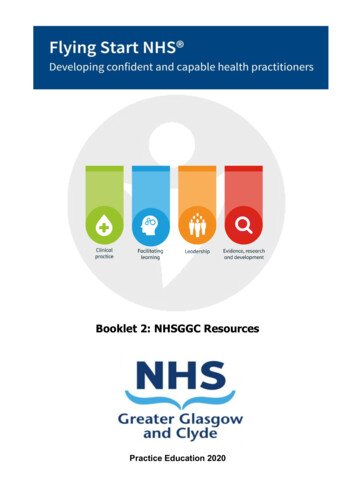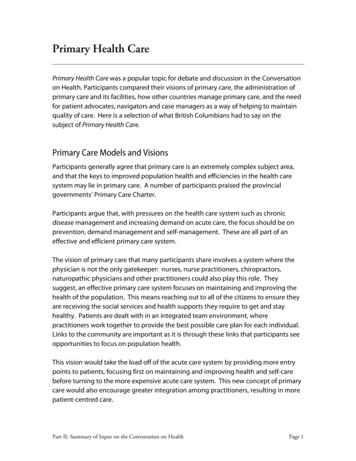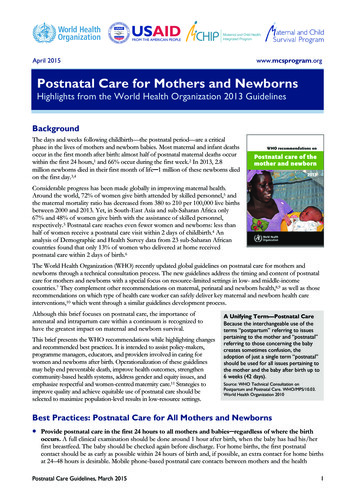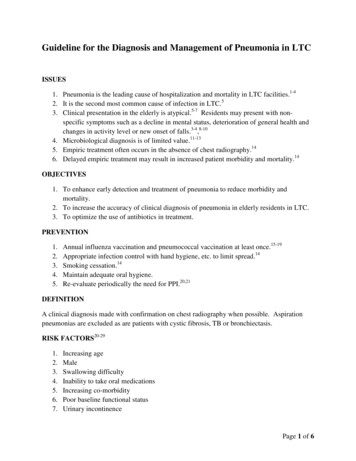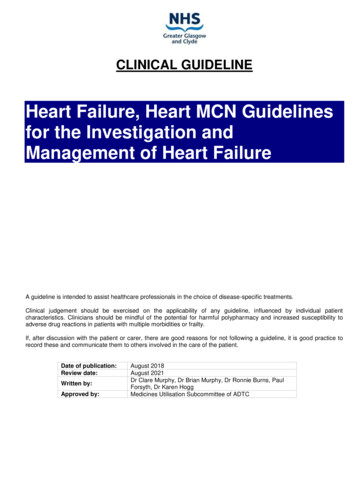
Transcription
CLINICAL GUIDELINEHeart Failure, Heart MCN Guidelinesfor the Investigation andManagement of Heart FailureA guideline is intended to assist healthcare professionals in the choice of disease-specific treatments.Clinical judgement should be exercised on the applicability of any guideline, influenced by individual patientcharacteristics. Clinicians should be mindful of the potential for harmful polypharmacy and increased susceptibility toadverse drug reactions in patients with multiple morbidities or frailty.If, after discussion with the patient or carer, there are good reasons for not following a guideline, it is good practice torecord these and communicate them to others involved in the care of the patient.Date of publication:Review date:Written by:Approved by:August 2018August 2021Dr Clare Murphy, Dr Brian Murphy, Dr Ronnie Burns, PaulForsyth, Dr Karen HoggMedicines Utilisation Subcommittee of ADTC
NHSGGC Guidelines For The Investigation and Management ofHeart FailureThis document can be accessed online at ocols/Suspicion of ‘new’ Heart Failure?Existing Known Heart Failure?Essential investigations- BNP or NT-proBNP blood tests- Ctrl & Click for detailed info on other Essential investigationIf suspected heart failure refer as per Heart Failure Diagnostic t-failure-diagnostic-pathway-dec-2017.pdfEMIS /VISION coding (read codes)If HF due to LVSD is confirmed please ensure patient is coded:- ‘Heart Failure’ G58- ‘Echo shows LVSD’ 585fTreatment-ACE Inhibitors or ARB (max tolerated dose) unless contraindicated- Ctrl & Click forinfo Treatment- ACE inhibitors (ACEI) & Treatment - Angiotensin receptor blockers (ARB)Beta Blockers (max tolerated dose) unless contraindicated- Ctrl & Click for infoTreatment- Beta blockers-Loop diuretic (to alleviate symptoms) - Ctrl &Click for info Treatment – Loop diureticLifestyle advice – Ctrl and click Treatment- Lifestyle changesNOIS PATIENT STILL SYMPTOMATIC?Usual Annual CareCtrl & Click for info Recommendations forUsual Annual CareMonitor:- NYHA- Check for fluid overload (e.g. peripheraloedema, PND / orthopnea)- Pulse rate and rhythm- Medication compliance- Lifestyle- U&E (including Near-Patient-Testing LES)if on Spironolactone or Eplerenone)YESTreatment- Loop diuretic can be increased upto maximum dose of Furosemide120mg (or equivalent)Ctrl & Click for info Treatment – LoopdiureticIS PATIENT STILL SYMPTOMATIC?NOYESPatient Symptomatic with no previous HF nurse involvement? OR Worsening symptoms and previously known to HF nurses? OR Admitted to hospital in last year with worsening HF but without cardiology / HF nurse input?Refer to General Cardiology or re-refer to the Heart Failure Nurse service if patient is alreadyknown to service Ctrl & Click for Heart failure nurse service contact details Ctrl & Click for Further Management– Other heart failure treatment options (under specialistguidance only)
1. Essential investigationIf patient symptoms and /or signs suggest heart failure and/or LVSD check: BNP or NTproBNP blood tests (BNP level 100 nanograms/L or NT-proBNP 400 nanograms/L) FBC (Anaemia may cause breathlessness) If new symptoms of breathlessness are present a CXR should be performed (if not performed within preceding6 months). CXR May show suspicion of heart failure or show lung disease. Blood glucose (high prevalence of diabetes in LVSD (any cause) TFTs (hypothyroidism may cause heart failure) Blood Chemistry (renal function pre ACE-I) Echocardiogram (use heart failure diagnostic pathway, this will incorporate ECG and/or BNP) Serum albumin to exclude nephritic syndromeCtrl &Click to return to PC guidelines for the investigation and management of LVSD2. Treatment- ACE inhibitors (ACEI)Who: All patients with LVSD regardless of symptomsWhy: Improves symptoms and prognosis in all grades of heart failure.General advice: Begin at lowest dose and up-titrate to maximum tolerated doseTarget doses: Ramipril 5mg twice daily (or 10mg once daily), lisinopril 30-35mg once daily or enalapril 10-20mgtwice daily.Monitoring: U&E must be checked at one week following initiation and each up titration to access renal function.Troubleshooting: If renal function deteriorating (decrease in GFR of 30%), consider stopping ACEI and seek specialist advice. If serum potassium level is 5.5 and 6 reduce the ACEI dose by 50% and recheck in a week, if the serumpotassium level is 6 stop ACEI and seek specialist advice If ACEI is not tolerated due to persistent dry cough substitute with an angiotensin receptor blocker (ARB)licensed for use in heart failure (see below)Click to return to PC guidelines for the investigation and management of LVSD3. Treatment - Angiotensin receptor blockers (ARB)Who: For patients intolerant of ACEI due to side effects (most commonly persistent dry cough) OR as add ontherapy in patients with ongoing symptoms in spite of ACEI and beta-blocker and intolerant of mineralocorticoidreceptor antagonists (under specialist guidance only)Why: Improves symptoms and prognosis in all grades of heart failure.General advice: Begin at lowest dose and up-titrate to maximum tolerated doseTarget doses: Candesartan 32 mg once daily, Valsartan 160mg twice daily (post MI heart failure only)Monitoring: If on monotherapy use the same monitoring as per ACE-I. If on dual therapy (i.e. ACEI AND ARB) thenuse the same monitoring as per mineralocorticoid receptor antagonist (see below MRA section)Troubleshooting: Same as ACEIClick to return to PC guidelines for the investigation and management of LVSD4. Treatment- Beta blockersWho: All patients with LVSD regardless of symptoms should be started on beta-blocker therapy as soon as theircondition is stable i.e. free from decompensated heart failure (unless contraindicated by a history of asthma orheart block)Why: Improves symptoms and prognosis in all grades of heart failure.General advice: Begin at lowest dose and up-titrate slowly at intervals of not less than two weeks to maximumtolerated dose. Beta –blocker treatment should be prescribed under the guidance of a health professionalexperienced in the management of heart failure. Diltiazem or verapamil must be discontinued.Target doses: Carvedilol 25mg twice daily (50mg twice daily if 85kgs), bisoprolol 10mg once daily, nebivolol 10mgonce daily. NB- Nebivolol is restricted to use only in those 70 years who are intolerant of both carvedilol andbisoprolol and only on the advice of an expert.Troubleshooting: Do not increase dose if heart rate 50bpm or systolic blood pressure 90mmHg.Other advice: Patients stabilised on another beta- blocker ( for e.g. CHD or hypertension), consider substituting ifclinically appropriate and patients heart failure condition is stable:Current Dose of AtenololApprox. Equivalent Dose of Bisoprolol Approx. Equivalent Dose of Carvedilol25mg daily1.25 – 2.5mg daily6.25mg twice daily50mg daily2.5 - 5mg daily12.5mg twice daily 50 mg daily5 - 10mg daily12.5 - 25mg twice dailySeek specialist advice if unsure. Equivalent dose chosen should be individualised, after assessment of heart rateand blood pressure. Review heart rate, blood pressure and clinical symptoms ideally 1 week after substitution.Optimise dose according to response, including heart rate.Click to return to PC guidelines for the investigation and management of LVSD
5. Treatment – Loop diureticWho: All patients with signs or symptoms of fluid retention (e.g. peripheral/pulmonary oedema, PND/orthopnoea orraised JVP)Why: Improves symptomsGeneral advice: Use the lowest dose of furosemide necessary to relieve peripheral oedema and signs ofpulmonary oedema. Start with furosemide 40 mg per day orally.Troubleshooting: Daily timing need not be fixed. Timing can be changed for social convenience. Dosing after 4pm, can lead tonocturia. If not effective in three days double dose – 40mgs b.d, 8am and 2pm If still not effective, increase up to 120mg and seek rapid specialist advice. Excessive diuretic therapy or intercurrent illness with vomiting/diarrhoea can lead to dehydration causinghypotension, renal dysfunction and gout. In the elderly, symptoms of hypovolaemia may be non-specific - washed out, confused, impaired mobility, fall,urinary incontinence.Other advice: Monitor for symptoms/signs of sodium and water depletion Postural dizziness/light headedness Excessive and sustained fall in blood pressure Significant and sustained weight loss below usual dry weight (e.g. 1 kg, sustained over 1 week).If patient has any such symptoms, measure U&Es immediately and seek advice from Heart Failure Liaison Servicewho can rapidly access a specialist cardiologist for advice.Click to return to PC guidelines for the investigation and management of LVSD6. Treatment- Lifestyle changesExercise- Patients should keep as active as possible.NYHA class 1 and 2 – encourage regular aerobic exercise e.g. walking, gardening, bowling, golfing. Aim toaccumulate 30 minutes or more of moderate intensity physical activity over the course of most days of the week.Use Live Active referral if needs more support and encouragement to get started.NYHA class 3 or 4 – do not avoid gentle exercise. Start with small amounts; the best and safest exercise is simplywalking; swimming is not advisable. Live Active referral NOT appropriate.Alcohol- Alcohol is contraindicated in those with alcoholic Cardiomyopathy. Otherwise can be taken in smallquantities, 1 or 2 units/daySmoking- All patients with heart failure should be strongly advised not to smoke and should be offered smokingcessation advice and support. NRT doubles the quit rate of smokers who want to stop. Consider referral to our localsmoke free pharmacy or to smoking cessation. Contact Quit Your Way 0800 848484 or Quit Your WayPharmacy 0141 201 4945 for further topping-smokingNutritionFruit juices: Avoid cranberry juice if taking warfarin (increased potency). Avoid grapefruit juice if taking simvastatin(interference with metabolism)Food supplements: Avoid St John’s Wort (interactions with warfarin, digoxin, eplerenone)High salt consumption increases water retention. Patients with heart failure avoid salt intake 6g/day.Salt avoidance- avoid salt rich foods e.g. cheese, bacon and ham , tinned meat, sausages and made up meatdishes (beef burgers, pies) crisps, salted peanuts and other salty snacks, smoked fish, most “fast” foods, tinned andpacket soup and stock cubes. Use low salt foods instead e.g. fresh fish, fruit, poultry and meat, fresh vegetables cooked without salt. Don’t add salt at table. Avoid salt replacements e.g. Lo Salt (high potassium content) soy, sauce, marmite Try to use herbs, spices, mustard, or lemon to add flavour instead.Consider dietician referral, especially ethnic groups with specific dietary considerations.Obesity- Encourage small step changes towards modest weight loss targets- try smaller portion on plates reducefat and sugary foods. Think of cakes biscuits etc as occasional treat. .Consider referral to GGC WeightManagement serviceCachexia- Encourage small and often eating, give advice regarding calorie dense foods.Leaflet available from Health Promotion- 0141 201 4915. Consider referral to dietitian.Click to return to PC guidelines for the investigation and management of LVSD
7. Recommendations for Usual Annual CareNYHA:NYHA INo symptoms and no limitation in ordinary physical activity.NYHA IIMild symptoms and slight limitation during ordinary activity. Comfortable at rest.NYHA IIIMarked limitation in activity due to symptoms, even during less-than-ordinary activity.Comfortable only at restNYHA IVSevere limitations. Experiences symptoms even while at rest.Ensure patient is on maximum tolerated drug therapy (Sections 2 – 5 above). If already achieved and symptomspersist or patients have increased NYHA class then contact HF nurses for advice about onward referral tocardiologist and/or palliation. Some patients may be persistently symptomatic but stable and may not require furtherHF team involvement, seek advice if unsure. If NYHA, IV ensure HF nurses are involved and patient is on GoldStandards Framework/Palliative Care register.Fluid status: See section 5 abovePulse rate: Check pulse annual to determine optimisation of beta-blocker. Sinus rhythm patients should ideally beoptimised to approximately 60bpm. Patients with AF are appropriate for more lenient control (e.g. 80bpm).Pulse rhythm: If new irregularity detected please consider atrial fibrillation. Refer to AF guidelines for uidelines.pdfMedication compliance: If patient has problems with compliance or needs specialist HF pharmacist advice pleaserefer to Pharmacy Heart Failure Service 0141-201-9398Lifestyle: See Section 6 aboveU&E: Patients should have at least one U&E check annually even if no drug or dose changes. Patients onSpironolactone or Eplerenone should be followed up as per the terms of the Near-Patient-Testing LES.Click to return to PC guidelines for the investigation and management of LVSD8. Further Management– Other heart failure treatment options (under specialist guidance only)a. Treatment- Mineralocorticoid receptor antagonist (Spironolactone/ Eplerenone)Who: Add on therapy to patients already on ACE-I (or ARB) and beta blocker in NYHA II – IV heart failure (underspecialist guidance only).Why: Improves symptoms and prognosis in patients NYHA II – IV and either LVEF 35% or LVEF 40% new heartattackDrug choice: Agent of choice is spironolactone 25 once daily (50mg once daily in exceptional situations) oreplerenone 25-50mg if hormonal side-effects with spironolactone.Contraindications: Serum potassium 5mmol/l and/or creatinine is, or ever been, 220µmol/l.Monitoring: Monitoring of urea and electrolytes: 1 week, 3 weeks and 7weeks after initiation, every 4 weeks for 3months, then every 3 months for 1 year and every 6 months, thereafter. Monitoring will be undertaken by theHFLNS until the patient is stable.Sick Day Rules / Patient Information: Temporary stop treatment if there is vomiting/diarrhoea. If symptoms persist 48hrs seek expert advice (includes HFLNS) because of increased risk of renal dysfunction/hyperkalaemia.Ensure patient has spironolactone or eplerenone monitoring card with information about the drug.Click to return to PC guidelines for the investigation and management of LVSDb. Treatment- Sacubitril/ValsartanWho: Alternative to ACEI (or ARB) in patients NYHA II – IV, LVEF 40%, ongoing symptoms despite optimaltreatment (e.g. beta blocker, ACEI or ARB, and either spironolactone or eplenerone) AND plasma B-type natriureticpeptide (BNP) level of at least 150 nanograms/L or N-terminal pro-BNP level (NT-proBNP) of at least 600nanograms/L (or, if they have been hospitalised for heart failure within the previous 12 months, a BNP of at least100 nanograms/L or NT-proBNP of at least 400 nanograms/L).Why: Improve quality of life and prognosis in such patients compared to ACEI (or ARB)Initiation Phase: Patients must have direct input by specialist NHSGGC heart failure teams. GPs should not beasked to initiate by NHSGGC specialist staff, other health boards, tertiary centres and/or private healthcare withoutlocal NHSGGC heart failure team involvement. Please contact local NHSGGC specialist heart failure teams ifunsure. All patients require an elevated BNP (or NT-proBNP) to qualify for initiation.Wash Out Period: If the patient is already prescribed an ACEI, the ACEI MUST be stopped 48 hours prior toinitiation of sacubitril/valsartan to minimise the risk of angioedema. The importance of this wash-out period mustALWAYS be communicated directly to the patient, to the GP (in writing) and, if the person receives a weeklyadherence aid, the community pharmacy (verbally, at the point the prescription is issued).Monitoring: All patients started on sacubitril/valsartan should have blood pressure and renal function rechecked 12 weeks after initiation and 1-2 weeks after any up-titration. These checks are the responsibility of the specialistheart failure teams and not of primary care (i.e. the GP). The specialist heart failure teams will deliver follow-upmonitoring (i.e. renal function, blood pressure and tolerance) in all patients for a minimum of six months postinitiation.Detailed advice: For in-depth detailed NHSGGC guidance on Sacubitril/Valsartan click here (link)Click to return to PC guidelines for the investigation and management of LVSD
c. Treatment- IvabradineWho: Add on therapy in NYHA II-IV, in patients in sinus rhythm and whose heart rate is 75bpm, in combinationwith standard therapy including beta-blocker therapy or when beta-blocker therapy is contra-indicated or nottolerated (under specialist guidance only).Why: Decreases heart failure hospitalisationsGeneral advice: Recommended starting dose is ivabradine 5 mg twice daily (2.5mg twice daily if 75 years old)and target dose is 7.5mg twice daily. NB- Ivabradine should not be initiated unless a beta-blocker has beenconsidered and/or fully optimisedClick to return to PC guidelines for the investigation and management of LVSDd. Treatment- Device therapyWho: Potential additional therapy in appropriate patients with moderate to severe LV dysfunction (LVEF 35%).Such patients should be considered for device therapy on an individual basis. The following table provides aframework to inform the decision-making process.LBBB Left bundle branch blockWhy: CRT can improve both symptoms and prognosis in appropriate patients and ICD can improve prognosis (nobenefit on symptoms)Click to return to PC guidelines for the investigation and management of LVSDe. Treatment- DigoxinWho: Patients with symptomatic heart failure, sinus rhythm and LVEF 40%.Why: Decreases heart failure hospitalisations (but evidence is weak and pre-dates most other modern treatments)General Advice: Doses between 62.5microgram and 250microgram daily can be used depending on body weightand renal function. Side effects include anorexia, nausea, vomiting, bradycardia, ventricular arrhythmias, visiondisturbances (e.g. xanthopsia). In the elderly, symptoms may be non-specific – See section on fluid retention above.If these occur, check blood digoxin level.Monitoring: Check U&Es before initiating therapy or if signs of toxicity (to exclude hypokalaemia and uraemia)Click to return to PC guidelines for the investigation and management of LVSDf. Treatment- Hydralazine-isosorbide dinitrate (ISDN)Who: For patients intolerant of ACEI or ARB due to renal dysfunction and/or hyperkalaemia.Why: Improved prognosis (but evidence is weak, from small numbers and pre-dates most other modern treatments)General Advice: Initial dose hydralazine 25mg/isosorbide dinitrate 10mg three times daily, increasing gradually(depending on tolerance) to a maximum hydralazine 75mg/ISDN 40mg tdsStarting DoseNext Titration StepTarget Dose25mg tds Hydralazine50mg tds Hydralazine75mg tds HydralazineClick to return to PC guidelines for the investigation and management of LVSDISDN 10mg tdsISDN 20mg tdsISDN 40mg tds
9. Treatment- Palliative / Supportive Care ApproachPatients with heart failure who remain symptomatic or continue to have hospital admissions despite evidencebased therapies should be considered for a collaborative cardiology and palliative approach to care. Cardiologytherapies should continue where clinically appropriate but in addition quality of life issues should be addressedsuch as the management of symptoms both cardiac and non-cardiac. Signposting to financial, social andpsychological support should also be provided where required after assessment. Early identification of patients withongoing symptoms and unmet needs allows for interventions to improve quality of life but in addition time to identifypatients' preferences and priorities of care necessary to develop tailored medical anticipatory care plans. Mostpatients require a generalist palliative approach integrated with their cardiac care but access to specialist palliativecare should be made available when needed.Click to return to PC guidelines for the investigation and management of LVSD10. Heart failure nurse service contact detailsTo arrange HFNLS follow up for patients who have had a recent admission to hospital with heart failure secondaryto LVSD and who have not been picked up by the service, contact your HFLNS to arrange follow-up. This can bedone by phone or in writing but not via cardiology SCI referral.Once heart failure symptoms are stable, treatment optimised and appropriate self management and social needsare met then patients will no longer receive planned HFLNS support. Any patient who develops worseningsymptoms however, may re-access the service either through their GP as indicated above, or may contact theservice themselves on the following numbers: Queen Elizabeth University Hospital - 0141 451 6132Glasgow Royal Infirmary - 0141 211 4543West of Glasgow ACH- 0141 201 0383Royal Alexandra Hospital - 0141 314 9701Victoria ACH -0141 347 8076Inverclyde Royal Hospital- 01475 505130Stobhill ACH - 0141 355 1840Click to return to PC guidelines for the investigation and management of LVSD
Obesity- Encourage small step changes towards modest weight loss targets- try smaller portion on plates reduce fat and sugary foods. Think of cakes biscuits etc as occasional treat. .Consider referral to GGC Weight Management service Cachexia- Encourage small and often eating, give advice regarding calorie dense foods.
